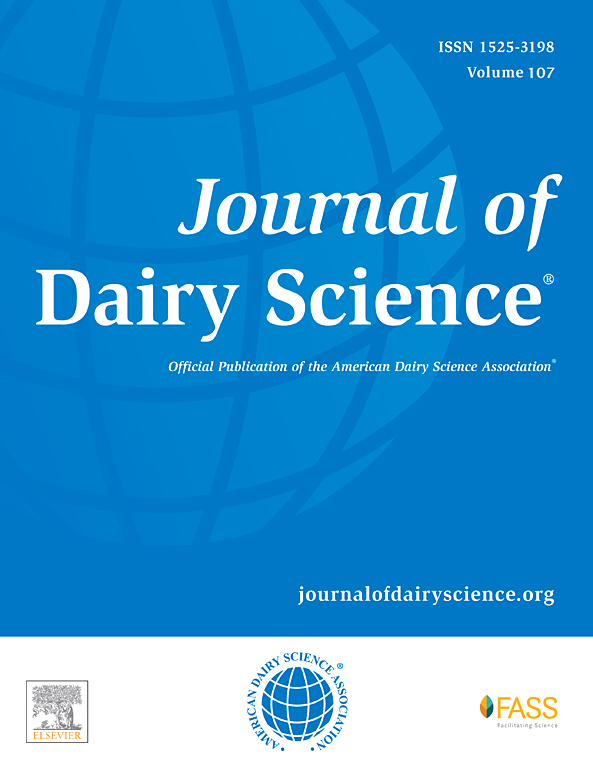腹腔灌注支链氨基酸或支链酮酸对多胎新鲜奶牛肝功能、炎症和氧化应激的影响
IF 3.7
1区 农林科学
Q1 AGRICULTURE, DAIRY & ANIMAL SCIENCE
引用次数: 0
摘要
泌乳早期肝功能降低、氧化应激增加和炎症会对新产奶牛的泌乳性能和健康产生负面影响。我们小组之前的研究结果表明,输注支链氨基酸(BCAA)可提高新产奶牛的泌乳性能,输注支链酮酸(BCKA)可降低肝脏甘油三酯(TG)。本研究的目的是确定 BCAA 和 BCKA 对血液和肝脏中肝功能、氧化应激和炎症的生物标志物以及肝脏中调节炎症和抗氧化代谢的基因表达的影响。在随机区组设计中,30 头多胎荷斯坦奶牛在产后 21 天内连续接受腹腔输注。处理(每组 10 头奶牛)为对照组(CON),即腹腔输注 0.9% 生理盐水;BCA,即腹腔输注 BCAA(67 克缬氨酸、50 克亮氨酸和 34 克异亮氨酸);BCK,即腹腔输注 BCKA(77 克酮戊氨酸、57 克酮亮氨酸和 39 克酮异亮氨酸)。所有奶牛在分娩后被随机分配到不同的处理中,并在整个实验期间接受相同的饮食。在产后 3、7、14 和 21 天采集血液,用于肝功能、氧化应激和炎症生物标志物分析。在产后 7、14 和 21 d 还采集了肝脏,用于定量检测谷胱甘肽、蛋白质羰基化和基因表达。使用 SAS 中的 PROC GLIMMIX 对所有数据进行方差分析。在肝功能生物标志物(胆红素、γ-谷氨酰转移酶和天冬氨酸氨基转移酶)方面未观察到治疗差异。与CON相比,接受BCAA治疗的奶牛血液中NO2-和NO3-浓度较低。与对照组相比,BCA奶牛的高级氧化蛋白产物也呈下降趋势。此外,在第 7 天,BCA 奶牛肝脏中的蛋白质羰基化程度低于 CON 奶牛。相比之下,BCK奶牛的血浆硫醇和白蛋白以及肝脏还原型谷胱甘肽和总谷胱甘肽均高于CON奶牛。与 CON 相比,BCK 奶牛肝脏中谷胱甘肽还原酶的表达量更高。总之,这些结果表明,在泌乳期的前三周,输注 BCAA 或 BCKA 的新鲜奶牛的氧化应激和炎症状态发生了有利的变化,这可能是之前观察到的泌乳性能和肝脏 TG 浓度变化的原因。未来的工作需要评估 BCAA 和 BCKA 的相互关联代谢,以更好地了解它们对氧化和免疫代谢的影响。本文章由计算机程序翻译,如有差异,请以英文原文为准。
Effects of abomasal infusion of branched-chain amino acids or branched-chain keto-acids on liver function, inflammation, and oxidative stress in multiparous fresh cows
Reduced liver function, increased oxidative stress, and inflammation in early lactation negatively affect lactation performance and health of fresh cows. Previous findings from our group demonstrated that branched-chain AA (BCAA) infusion improved lactation performance and branched-chain keto-acids (BCKA) infusion decreased liver triglyceride (TG) in fresh cows. The objectives of this study were to determine the effect of BCAA and BCKA on blood and liver biomarkers of liver function, oxidative stress, and inflammation as well as expression of genes regulating inflammation and antioxidant metabolism in the liver. Thirty multiparous Holstein cows were used in a randomized block design receiving continuous abomasal infusion for 21 d after parturition. Treatments (10 cows each) were control (CON), cows abomasally infused with 0.9% saline; cows abomasally infused with BCAA (67 g valine, 50 g leucine, and 34 g isoleucine; BCA); and cows abomasally infused with BCKA (77 g keto-valine, 57 g keto-leucine, and 39 g keto-isoleucine; BCK). All cows were randomly assigned to treatments after parturition and received the same diet throughout the experimental period. Blood was collected at 3, 7, 14, and 21 d postpartum for liver function, oxidative stress, and inflammation biomarker profiling. Liver was also harvested on 7, 14, and 21 d postpartum for quantification of glutathione, protein carbonylation, and expression of genes. ANOVA was conducted for all data using PROC GLIMMIX in SAS. No treatment differences were observed for liver function biomarkers (bilirubin, gamma-glutamyl transferase, and aspartate aminotransferase). Cows receiving BCAA had lower blood NO2− and NO3− concentrations compared with CON. A tendency for lower advanced oxidized protein products was also observed in BCA cows compared with CON. Additionally, on d 7, BCA cows had lower protein carbonylation in the liver compared with CON. In contrast, BCK cows had higher plasma thiol and albumin, as well as liver reduced and total glutathione compared with CON cows. Compared with CON, BCK cows had higher expression glutathione reductase in the liver. Overall, these results suggest favorable alterations in oxidative stress and inflammation status in fresh cows receiving BCAA or BCKA infusion during the first 3 wk of lactation, which likely contributed to previously-observed changes in lactation performance and liver TG concentrations. Future work is required to evaluate the interrelated metabolism of BCAA and BCKA to better understand their effects on oxidative and immune metabolism.
求助全文
通过发布文献求助,成功后即可免费获取论文全文。
去求助
来源期刊

Journal of Dairy Science
农林科学-奶制品与动物科学
CiteScore
7.90
自引率
17.10%
发文量
784
审稿时长
4.2 months
期刊介绍:
The official journal of the American Dairy Science Association®, Journal of Dairy Science® (JDS) is the leading peer-reviewed general dairy research journal in the world. JDS readers represent education, industry, and government agencies in more than 70 countries with interests in biochemistry, breeding, economics, engineering, environment, food science, genetics, microbiology, nutrition, pathology, physiology, processing, public health, quality assurance, and sanitation.
 求助内容:
求助内容: 应助结果提醒方式:
应助结果提醒方式:


